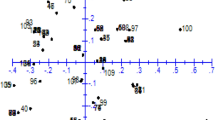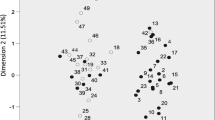Abstract
Genetic diversity in 31 individuals from 14 coconut populations across the entire geographic range (2–3 individuals per population) was assessed using sequence-tagged microsatellites (or simple sequence repeats, SSRs) and amplified fragment length polymorphism (AFLP). From the 39 SSR primer sets tested, only two gave patterns that could not be scored and used in the data analysis. The remainder included five SSRs that gave double-locus profiles in which one locus could still be scored separately. The 37 SSRs revealed between 2 and 16 alleles per locus and a total of 339 alleles in the 14 populations. Gene diversity (D = 1-Σpi 2) ranged from 0.47 to 0.90. Two of the four Dwarf populations were homozygous at all 37 loci, which is consistent with their autogamous (self-fertilising) reproduction. One Dwarf population was heterozygous at one locus but the other (Niu Leka Dwarf), which is known to be cross-pollinating, showed high levels of heterozygosity. Generally, diversity was higher in populations from the South Pacific and South East Asia. Three SSR loci (CNZ46, CN2A5, CN11E6) gave distinct genotypes for all but two populations. The East African populations had higher heterozygosities than those from West Africa, and the populations from Tonga and Fiji generally had distinct alleles from those of the South Pacific. AFLP analysis with 12 primer combinations gave a total of 1106 bands, of which 303 were polymorphic (27%). Similarity matrices were constructed from the two data sets using the proportion of shared alleles for SSRs and a Jaccard coefficient for AFLPs. In each case cluster and principal co-ordinates analyses were performed, with the resultant dendrograms and plots revealing similar relationships among the populations for both approaches. There was generally a good separation of populations, and phenetic relationships were in agreement with those previously shown by RFLPs. The use of SSRs and AFLPs in genetic-diversity analysis for the establishment of germplasm collections is discussed.
Similar content being viewed by others
Author information
Authors and Affiliations
Additional information
Received: 27 October 1998 / Accepted: 31 March 1999
Rights and permissions
About this article
Cite this article
Teulat, B., Aldam, C., Trehin, R. et al. An analysis of genetic diversity in coconut (Cocos nucifera) populations from across the geographic range using sequence-tagged microsatellites (SSRs) and AFLPs. Theor Appl Genet 100, 764–771 (2000). https://doi.org/10.1007/s001220051350
Issue Date:
DOI: https://doi.org/10.1007/s001220051350




